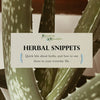Herbal Tea Infusions: Cold or Hot ?

Depending on where you live, you may prefer to switch the temperature of your teas and coffee beverages throughout the year. When it comes to herbal tea blends or tisanes, some herbal components are extracted better in cold or hot infusions. So if you are drinking the tea for medicinal purposes, that may be a factor. In this post, let’s discuss it a bit more.
Hot Infusions
When using hot water to steep your herbs for that nice cup of hot tea, there’s a few things going on in your mug. First, the hot water will cause plant cells to burst and break down, releasing their components into the water. Starches, sugars, gums, and mineral salts will also start to break down.
As the hot infusion progresses, more plant material like tannins and iridoids (anti-inflammatory components) will be extracted. Essential or volatile oils will begin to evaporate - which is why you should cover your tea while seeping. Larger molecules like caffeine and polyphenols (also good for antioxidants and anti-inflammatory effects) will extract later in the infusion. If seeping too long or at too high a temperature, more tannins and astringent flavors will develop, and the tea could become too bitter.
Hot infusions typically yield a more robust, flavorful tea. Plus, it is fairly quick to prepare. Many flowers, leaves and roots make good hot infusions. Tannins extract better in warmer infusions: tannins may lower total cholesterol and blood pressure, stimulate the immune system, and have antibacterial properties.
Some herbal components like barks and roots, may require longer brewing, such as when we make a decoction. Decoctions are made by simmering the herbs for a period or time, rather than just pouring hot water on top.
Cold Infusions
Cold infusions are best made by soaking herbs in a bag in cold water for anywhere from 4 to 24 hours. Once prepared, tea/tisane infusions can be refrigerated for up to 2 days.
One of the benefits of a cold infusion is that mucilaginous components (slippery carbohydrates) and polysaccharides will be more prevalent in cold infusions than warm infusions. Mucilaginous compounds are very effective at soothing inflamed tissues, whether it is in your throat, lungs or bowel.
Cold infusions may be better for marshmallow, hibiscus, psyllium, mullein, plantain, fenugreek comfrey and slippery elm due to their high mucilaginous components. Buckthorn, witch hazel and sarsparilla may also benefit from cold infusions.
Cold infusions will also have more volatile oils preserved (rather than evaporated), so herbs like lavender, mints, and lemon balm may offer more delicate flavors in a cold infusion. Longer cold infusions will yield a sweeter tea, and may be higher in antioxidants too.
So Which Infusion is Best?
People like what they like: you will benefit by drinking your herbal tisane from your hot mug or iced tumbler. That said, there are benefits to preparing your tea by either process if you are making it for a specific reason.
Cold infusions are less robust and require a bit more quantity than a hot infusion, but they do offer natural sweetness and subtle flavors that you may miss in a hot infusion.
At Raindrop Remedies, our herbal tea blends and tisanes are tasty hot or cold, so be sure to experiment and find out which blend you like better hot or cold!





